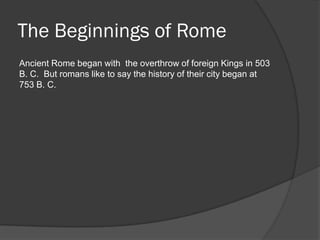
The beginnings of rome
- 1. The Beginnings of Rome Ancient Rome began with the overthrow of foreign Kings in 503 B. C. But romans like to say the history of their city began at 753 B. C.
- 2. The Founding of Rome The legend keeps going with the twins Romulus and Remus the descendants of Aeneas who founded Rome. Their mother abandoned them, but they were saved by a wolf. When the twins grew up they fought over Rome’s location so Romulus killed his brother Remus and traced Rome’s location around Palatine hill. After Romulus a series of Roman kings ruled the city. In the 600s B. C. the Etruscans from northern Italy conquered Rome. In order to regain self-rule the romans overthrew the Etruscans King.
- 3. Romes Geography and Early Life Over throw of Estrucans Rome grew from a city to a country, and eventually into an empire
- 4. Hills and Rivers 1st settlers of Rome were Latin They built Rome on seven steep hills They chose Rome for it’s mild climate, good farmland, and strategic location Located a short distance from the Mediterranean Sea on ancient trade routes, it also lay next to the Tiber River, an important resource
- 5. Italian Peninsula Location on Italian Peninsula played important role in development The 2 main mountain ranges of Italy helped protect Rome The Alps border Italy on the North and the Apennies form Italy’s spine Italy also had big plains that were good farming
- 6. Farm Life Roman farmers planted wheat, barley, beans, vegetables, and fruit. They later planted olives and grapes. They raised pigs, goats, sheep, and chickens. They used oxen to pull their plows. Most Roman farmers lived in simple homes of mud or timber.
- 7. Farm Life Most Roman farmers lived in simple homes of mud or timber. Had little furniture. Lived with grandparents, aunts& uncles, nieces& nephews, or cousins. They had to obey the orders they got.
- 8. Rise of the Republic • Rome developed into 2 classes the Patricians and the Plebeians • There was a conflict between the two classes; when the conflict ended it defined the citizens rights ○ They used this system for 500 years to keep the people under control
- 9. • Patricians were wealthy land owners that had seats in the gov’t • Upper class • Plebeians were commoners that had the right to vote but didn’t have gov’t seats • Lower class • The Twelve Tables was a system made around 450b.c. to establish basic rights and duties • Made by patricians
- 10. The leaders of the Roman republic established a tripartite government.
- 11. The type of government has three branches legislative judicial executive
- 12. Types and what they do Legislative: makes laws Judicial: interprets law in court Executive: enforces a country’s laws
- 13. Legislative branch included the senate and the assemblies
- 14. The senate Was made up of 300 Judicial branch members that advise consisted of eight Roman leaders. judges they served for Most senators were one year. patricians. They oversaw the The assemblies were courts and governed made up of plebeians. the provinces. Their representatives 2 consuls led Rome’s protected the rights of executive branch. plebeian. For 1 year they commanded the army and the directed the government.
- 15. Going on each consul had the power to veto or overrule the other. In times of crisis the consuls could choose a dictator – a leader with absolute power.
- 16. The republic expands For hundred of years after the founding of the republic, Rome expanded it territories. By the 300s B.C., the Romans dominated central Italy. By 275 B.C., all of the and the Italian Peninsula was under Roman control. Rome did not impose harsh rule on conquered peoples. The republic offered Roman citizenship to most of them and allowed them to govern themselves. In return , the new citizens had to pay taxes and provide soldiers for the Roman army.
- 17. 264 B.C • Rome needed soldiers to fight in Punic wars • These were a series of 3 wars with Carthage, a rich trading city in North Africa • Rome won all of the wars and almost lost the second • Hannibal, a general from Carthage, crossed the Alphas with a hard of elephants and nearly captured Rome • The Roman general Scipio devised a plan to attack Carthage • The plan forced Hannibal to return to Africa to defend his native city 202 B.C • At Zama near Carthage, Romans defeated Hannibal • 146 B.C • 3 Punic war Rome laid siege to Carthage • Rome captured and destroyed the city and set it on fire and its 50,000 inhabitants sold into slavery • Then made a Roman province
- 18. Romans brought great wealth and slaves They bought large estates and farmed them with slaves But because many small farmers couldn’t compete, they lost their farms Unemployment and poverty increased The gap between rich and poor grew wider
- 19. Romans brought great wealth and slaves They bought large estates and farmed them with slaves But because many small farmers couldn’t compete, they lost their farms Unemployment and poverty increased The gap between rich and poor grew wider